: 2025
: 2024
: 2023
: 2022
: 2021
: 2020
: 2019
: 2018
: 2017
: 2016
: 2015
: 2014
: 2013
: 2012
: 2011
: 2010
: 2009
: 2008
: 2007
:



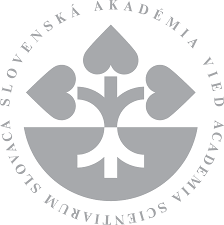



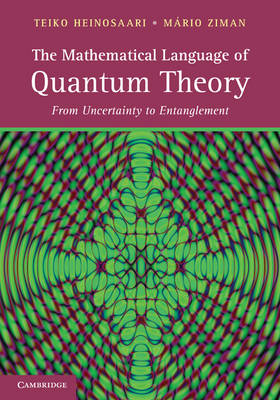
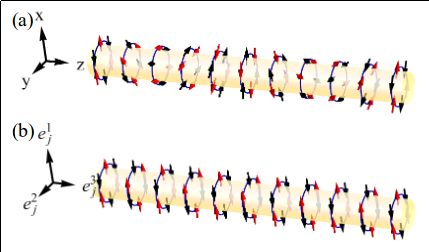 21.12.2015 Research publication
21.12.2015 Research publication
Antiferromagnetic nuclear spin helix and topological superconductivity in C13 nanotubes
We investigate the Ruderman-Kittel-Kasuya-Yosida (RKKY) interaction arising from the hyperfine coupling between localized nuclear spins and conduction electrons in interacting C13 carbon nanotubes. Using the Luttinger liquid formalism, we show that the RKKY interaction is sublattice dependent, consistent with the spin susceptibility calculation in noninteracting carbon nanotubes, and it leads to an antiferromagnetic nuclear spin helix in finite-size systems. The transition temperature reaches up to tens of mK, due to a strong boost by a positive feedback through the Overhauser field from ordered nuclear spins. Similar to GaAs nanowires, the formation of the helical nuclear spin order gaps out half of the conduction electrons, and is therefore observable as a reduction of conductance by a factor of 2 in a transport experiment. The nuclear spin helix leads to a density wave combining spin and charge degrees of freedom in the electron subsystem, resulting in synthetic spin-orbit interaction, which induces nontrivial topological phases. As a result, topological superconductivity with Majorana fermion bound states can be realized in the system in the presence of proximity-induced superconductivity without the need of fine tuning the chemical potential. We present the phase diagram as a function of system parameters, including the pairing gaps, the gap due to the nuclear spin helix, and the Zeeman field perpendicular to the helical plane.
by
Chen-Hsuan Hsu, Peter Stano, Jelena Klinovaja, and Daniel Loss
Phys. Rev. B 92, 235435 (2015) |+++| QIMABOS (APVV-0808-12) |
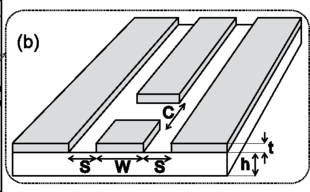 8.12.2015 Research publication
8.12.2015 Research publication
Finite quasiparticle lifetime in disordered superconductors
We investigate the complex conductivity of a highly disordered MoC superconducting film with kFl≈1, where kF is the Fermi wave number and l is the mean free path, derived from experimental transmission characteristics of coplanar waveguide resonators in a wide temperature range below the superconducting transition temperature Tc. We find that the original Mattis-Bardeen model with a finite quasiparticle lifetime, τ, offers a perfect description of the experimentally observed complex conductivity. We show that τ is appreciably reduced by scattering effects. Characteristics of the scattering centers are independently found by scanning tunneling spectroscopy and agree with those determined from the complex conductivity.
by
M. Žemlička, P. Neilinger, M. Trgala, M. Rehák, D. Manca, M. Grajcar, P. Szabó, P. Samuely, Š. Gaži, U. Hübner, V. M. Vinokur, and E. Il'ichev
Phys. Rev. B 92, 224506 (2015) |+++| QIMABOS (APVV-0808-12) |
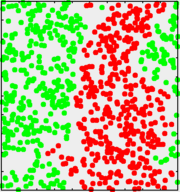 04.11.2015 Research publication
04.11.2015 Research publication
Reentrant disorder-disorder transitions in generalized multicomponent Widom-Rowlinson models
In the lattice version of the multicomponent Widom-Rowlinson (WR) model, each site can be either empty or singly occupied by one of M different particles, all species having the same fugacity z. The only nonzero interaction potential is a nearest-neighbor hard-core exclusion between unlike particles. For M < M0 with some minimum M0 dependent on the lattice structure, as z increases from 0 to ∞ there is a direct transition from the disordered (gas) phase to a demixed (liquid) phase with one majority component at z > zd (M). If M M0 , there is an intermediate ordered “crystal phase” (composed of two nonequivalent even and odd sublattices) for z lying between zc (M) and zd (M) which is driven by entropy. We generalize the multicomponent WR model by replacing the hard-core exclusion between unlike particles by more realistic large (but finite) repulsion. The model is solved exactly on the Bethe lattice with an arbitrary coordination number. The numerical calculations, based on the corner transfer matrix renormalization group, are performed for the two-dimensional square lattice. The results for M = 4 indicate that the second-order phase transitions from the disordered gas to the demixed phase become of first order, for an arbitrarily large finite repulsion. The results for M M0 show that, as the repulsion weakens, the region of the crystal phase diminishes itself. For weak enough repulsions, the direct transition between the crystal and demixed phases changes into a separate pair of crystal-gas and gas-demixed transitions; this is an example of a disorder-disorder reentrant transition via an ordered crystal phase. If the repulsion between unlike species is too weak, the crystal phase disappears from the phase diagram. It is shown that the generalized WR model belongs to the Ising universality class.
by
Roman Krčmár and Ladislav Šamaj
Physical Review E 92, 052103 (2015) |+++| QIMABOS (APVV-0808-12) |
 13.10.2015 Research publication
13.10.2015 Research publication
Process estimation in the presence of time-invariant memory effects
Any repeated use of a fixed experimental instrument is subject to memory effects. We design an estimation method uncovering the details of the underlying interaction between the system and the internal memory without having any experimental access to memory degrees of freedom. In such case, by definition, any memoryless quantum process tomography (QPT) fails because the observed data sequences do not satisfy the elementary condition of statistical independence. However, we show that the randomness implemented in certain QPT schemes is sufficient to guarantee the emergence of observable “statistical” patterns containing complete information on the memory channels. We demonstrate the algorithm in detail for the case of qubit memory channels with two-dimensional memory. Interestingly, we find that for the arbitrary estimation method, the memory channels generated by controlled unitary interactions are indistinguishable from memoryless unitary channels.
by
Tomáš Rybár and Mário Ziman
Phys. Rev. A 92, 042315 |+++| SIQS (FP7-ICT 2013-600645) QIMABOS (APVV-0808-12) QUICOST (VEGA 2/0125/13) |
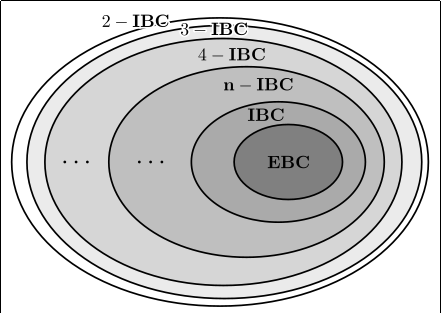 7.10.2015 Research publication
7.10.2015 Research publication
Incompatibility breaking quantum channels
A typical bipartite quantum protocol, such as EPR-steering, relies on two quantum features, entanglement of states and incompatibility of measurements. Noise can delete both of these quantum features. In this work we study the behavior of incompatibility under noisy quantum channels. The starting point for our investigation is the observation that compatible measurements cannot become incompatible by the action of any channel. We focus our attention to channels which completely destroy the incompatibility of various relevant sets of measurements. We call such channels incompatibility breaking, in analogy to the concept of entanglement breaking channels. This notion is relevant especially for the understanding of noise-robustness of the local measurement resources for steering.
by
Teiko Heinosaari, Jukka Kiukas, Daniel Reitzner and Jussi Schultz
J. Phys. A: Math. Theor. 48, 435301 (2015) |+++| QIMABOS (APVV-0808-12), QWIN (SASPRO 0055/01/01), QWIN (VEGA 2/0151/15) |
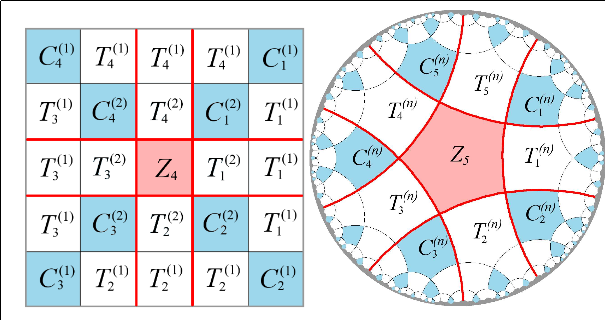 7.10.2015 Research publication
7.10.2015 Research publication
Tensor product variational formulation applied to pentagonal lattice
The uniform two-dimensional variational tensor product state is applied to the transverse-field Ising, XY, and Heisenberg models on a regular hyperbolic lattice surface. The lattice is constructed by tessellation of the congruent pentagons with the fixed coordination number being four. As a benchmark, the three models are studied on the flat square lattice simultaneously. The mean-field-like universality of the Ising phase transition is observed in full agreement with its classical counterpart on the hyperbolic lattice. The tensor product ground state in the thermodynamic limit has an exceptional three-parameter solution. The variational ground-state energies of the spin models are calculated.
by
Michal Daniška and Andrej Gendiar
J. Phys. A: Math. Theor. 48, 435301 (2015) |+++| SIQS (FP7-ICT 2013-600645), QIMABOS (APVV-0808-12), (VEGA-2/0130/15), |
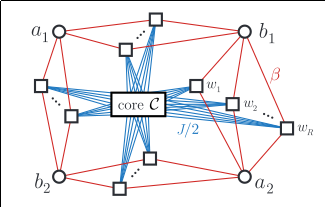 1.10.2015 Research publication
1.10.2015 Research publication
Perturbative gadgets without strong interactions
Perturbative gadgets are used to construct a quantum Hamiltonian whose low-energy subspace approximates a given quantum $k$-local Hamiltonian up to an absolute error $\epsilon$. Typically, gadget constructions involve terms with large interaction strengths of order $\text{poly}(\epsilon^{-1})$. Here we present a 2-body gadget construction and prove that it approximates a Hamiltonian of interaction strength $\gamma = O(1)$ up to absolute error $\epsilon\ll\gamma$ using interactions of strength $O(\epsilon)$ instead of the usual inverse polynomial in $\epsilon$. A key component in our proof is a new condition for the convergence of the perturbation series, allowing our gadget construction to be applied in parallel on multiple many-body terms. We also discuss how to apply this gadget construction for approximating 3- and $k$-local Hamiltonians. The price we pay for using much weaker interactions is a large overhead in the number of ancillary qubits, and the number of interaction terms per particle, both of which scale as $O(\text{poly}(\epsilon^{-1}))$. Our strong-from-weak gadgets have their primary application in complexity theory (QMA hardness of restricted Hamiltonians, a generalized area law counterexample, gap amplification), but could also motivate practical implementations with several weak interactions simulating a much stronger quantum many-body interaction.
by
Yudong Cao and Daniel Nagaj
Quantum Information & Computation 15, No.13&14, pp1197-1222 (2015) |+++| QIMABOS (APVV-0808-12) |
 1.9.2015 People
1.9.2015 People
New SASPRO fellow Daniel Nagaj A prestiguous Slovak Academy of Sciences postdoctoral research fellowship SASPRO was awarded to Daniel Nagaj. As SASPRO fellow he will be working on his project entitled "Local hamiltonians and quantum complexity". |
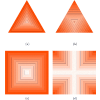 2.7.2015 Research publication
2.7.2015 Research publication
Exploring boundaries of quantum convex structures: Special role of unitary processes
We address the question of finding the most unbalanced convex decompositions into boundary elements (so-called boundariness) for sets of quantum states, observables, and channels. We show that in general convex sets the boundariness essentially coincides with the question of the most distinguishable element, thus providing an operational meaning for this concept. Unexpectedly, we discovered that for any interior point of the set of channels the most unbalanced decomposition necessarily contains a unitary channel. In other words, for any given channel the most distinguishable one is some unitary channel. Further, we prove that boundariness is submultiplicative under the composition of systems and explicitly evaluate its maximal value that is attained only for the most mixed elements of the considered sets.
by
Zbigniew Puchała, Anna Jenčová, Michal Sedlák, and Mário Ziman
Phys. Rev. A 92, 012304 (2015) |+++| QUICOST (VEGA 2/0125/13), MP1006 COST Action |
 11.6.2015 Popular talk (in Slovak)
11.6.2015 Popular talk (in Slovak)
Daniel Nagaj: Čudesné pôsobenie na diaľku
Príbeh o fyzike a komunikácii pomalej aj nekonečne rýchlej, verejnej aj dokonale utajenej. Oddávna ľudia po sebe kričia, posielajú dymové signály, telegrafujú po drôte aj bez neho, alebo si blikajú laserom. Nič z toho nám nepomôže preniesť informáciu na diaľku okamžite. Je naozaj rýchlosť komunikácie obmedzená fyzikou? Budeme sa spolu pýtať, či by nám nepomohli zvláštne (previazané) stavy kvantovej mechaniky a kolaps vlnovej funkcie pri meraní. Umožní nám to okamžite komunikovať (a ak nie, prečo)? Či bude odpoveď taká alebo onaká, na niečo zaujímavé to potom použijeme.
|youtube video| |
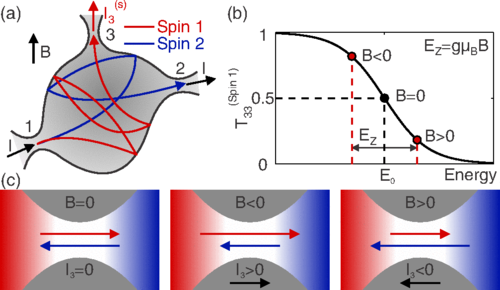 18.5.2015 Research publication
18.5.2015 Research publication
Generation and Detection of Spin Currents in Semiconductor Nanostructures with Strong Spin-Orbit Interaction
Storing, transmitting, and manipulating information using the electron spin resides at the heart of spintronics. Fundamental for future spintronics applications is the ability to control spin currents in solid state systems. Among the different platforms proposed so far, semiconductors with strong spin-orbit interaction are especially attractive as they promise fast and scalable spin control with all-electrical protocols. Here we demonstrate both the generation and measurement of pure spin currents in semiconductor nanostructures. Generation is purely electrical and mediated by the spin dynamics in materials with a strong spin-orbit field. Measurement is accomplished using a spin-to-charge conversion technique, based on the magnetic field symmetry of easily measurable electrical quantities. Calibrating the spin-to-charge conversion via the conductance of a quantum point contact, we quantitatively measure the mesoscopic spin Hall effect in a multiterminal GaAs dot. We report spin currents of 174 pA, corresponding to a spin Hall angle of 34%.
by
Fabrizio Nichele, Szymon Hennel, Patrick Pietsch, Werner Wegscheider, Peter Stano, Philippe Jacquod, Thomas Ihn, and Klaus Ensslin
Phys. Rev. Lett. 114, 206601 (2015) |+++| |
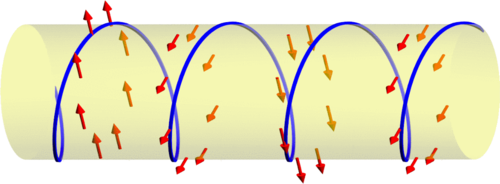 18.5.2015 Research publication
18.5.2015 Research publication
Voltage-induced conversion of helical to uniform nuclear spin polarization in a quantum wire
We study the effect of bias voltage on the nuclear spin polarization of a ballistic wire, which contains electrons and nuclei interacting via hyperfine interaction. In equilibrium, the localized nuclear spins are helically polarized due to the electron-mediated Ruderman-Kittel-Kasuya-Yosida (RKKY) interaction. Focusing here on nonequilibrium, we find that an applied bias voltage induces a uniform polarization, from both helically polarized and unpolarized spins available for spin flips. Once a macroscopic uniform polarization in the nuclei is established, the nuclear spin helix rotates with frequency proportional to the uniform polarization. The uniform nuclear spin polarization monotonically increases as a function of both voltage and temperature, reflecting a thermal activation behavior. Our predictions offer specific ways to test experimentally the presence of a nuclear spin helix polarization in semiconducting quantum wires.
by
Viktoriia Kornich, Peter Stano, Alexander A. Zyuzin, and Daniel Loss
Phys. Rev. B 91, 195423 (2015) |+++| |
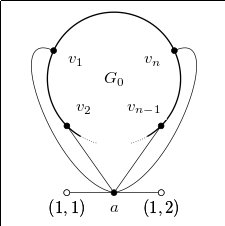 1.5.2015 Research publication
1.5.2015 Research publication
Momentum switches
Certain continuous-time quantum walks can be viewed as scattering processes. These processes can perform quantum computations, but it is challenging to design graphs with desired scattering behavior. In this paper, we study and construct momentum switches, graphs that route particles depending on their momenta. We also give an example where there is no exact momentum switch, although we construct an arbitrarily good approximation.
by
Andrew M. Childs, David Gosset, Daniel Nagaj, Mouktik Raha, Zak Webb
Quantum Information and Computation 15, 601-621 (2015) |+++| QIMABOS (APVV-0808-12) |
 1.4.2015 People
1.4.2015 People
New SASPRO fellow Daniel Reitzner A prestiguous Slovak Academy of Sciences postdoctoral research fellowship SASPRO was awarded to Daniel Reitzner. As SASPRO fellow he will be working on his project entitled "Quantum walks and incompatibility". |
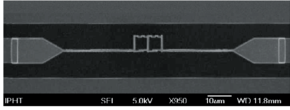 19.3.2015 Research publication
19.3.2015 Research publication
Two-photon lasing by a superconducting qubit
We study the response of a magnetic-field-driven superconducting qubit strongly coupled to a superconducting coplanar waveguide resonator. We observed a strong amplification/damping of a probing signal at different resonance points corresponding to a one- and two-photon emission/absorption. The sign of the detuning between the qubit frequency and the probe determines whether amplification or damping is observed. The larger blue detuned driving leads to two-photon lasing, while the larger red detuning cools the resonator. Our experimental results are in good agreement with the theoretical model of qubit lasing and cooling at the Rabi frequency.
by
P. Neilinger, M. Rehák, M. Grajcar, G. Oelsner, U. Hübner, and E. Il'ichev
Phys. Rev. B 91, 104516 (2015) |+++| QIMABOS (APVV-0808-12) |
 17.2.2015 Research publication
17.2.2015 Research publication
Simulating long-distance entanglement in quantum spin chains by superconducting flux qubits
We investigate the performance of superconducting flux qubits for the adiabatic quantum simulation of long-distance entanglement (LDE), namely, a finite ground-state entanglement between the end spins of a quantum spin chain with open boundary conditions. As such, LDE can be considered an elementary precursor of edge modes and topological order. We discuss two possible implementations which simulate open chains with uniform bulk and weak end bonds, either with Ising or with XX nearest-neighbor interactions. In both cases, we discuss a suitable protocol for the adiabatic preparation of the ground state in the physical regimes featuring LDE. In the first case, the adiabatic manipulation and the Ising interactions are realized using dc currents, while in the second case microwaves fields are used to control the smoothness of the transformation and to realize the effective XX interactions. We demonstrate the adiabatic preparation of the end-to-end entanglement in chains of four qubits with realistic parameters and on a relatively fast time scale.
by
Stefano Zippilli, Miroslav Grajcar, Evgeni Il'ichev, and Fabrizio Illuminati
Phys. Rev. A 91, 022315 (2015) |+++| QIMABOS (APVV-0808-12) |
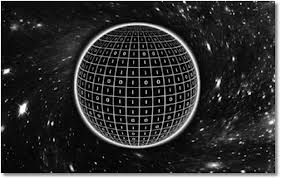 14.1.2015 Lectures
14.1.2015 Lectures
The firewall paradox from the general relativity theory perspective The series of lectures will be given by Martin Scholtz from Faculty of Mathematics and Physics of Charles Univsersity in Prague. Lectures plan (in Slovak):
Time: 2-5.2.2015 (Monday-Thursday), 10:30-12:30. |
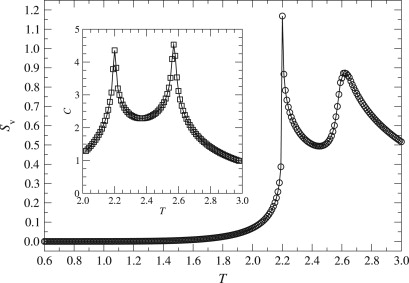 15.2.2015 Research publication
15.2.2015 Research publication
Thermodynamic model of social influence on two-dimensional square lattice: Case for two features
We propose a thermodynamic multi-state spin model in order to describe equilibrial behavior of a society. Our model is inspired by the Axelrod model used in social network studies. In the framework of the statistical mechanics language, we analyze phase transitions of our model, in which the spin interaction J is interpreted as a mutual communication among individuals forming a society. The thermal fluctuations introduce a noise T into the communication, which suppresses long-range correlations. Below a certain phase transition point Tt, large-scale clusters of the individuals, who share a specific dominant property, are formed. The measure of the cluster sizes is an order parameter after spontaneous symmetry breaking. By means of the Corner transfer matrix renormalization group algorithm, we treat our model in the thermodynamic limit and classify the phase transitions with respect to inherent degrees of freedom. Each individual is chosen to possess two independent features f and each feature can assume one of q traits (e.g. interests). Hence, each individual is described by q2 degrees of freedom. A single first-order phase transition is detected in our model if q>2, whereas two distinct continuous phase transitions are found if q=2 only. Evaluating the free energy, order parameters, specific heat, and the entanglement von Neumann entropy, we classify the phase transitions Tt(q) in detail. The permanent existence of the ordered phase (the large-scale cluster formation with a non-zero order parameter) is conjectured below a non-zero transition point Tt(q)=0.5 in the asymptotic regime of infinite q.
by
Jozef Genzor, Vladimír Bužek, Andrej Gendiar
Physica A 420, 200-211 (2015) [arXiv:1403.1771] |+++| QIMABOS (APVV-0808-12) DARG (VEGA-2/0074/12), SIQS (No.600645) |


